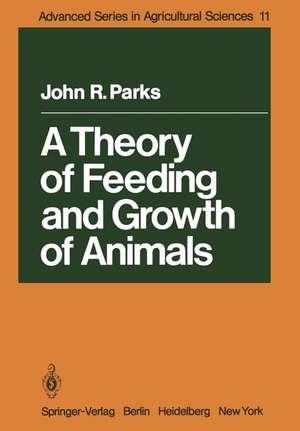A Theory of Feeding and Growth of Animals: Advanced Series in Agricultural Sciences, cartea 11
Autor John R Parksen Limba Engleză Paperback – 28 oct 2011
Din seria Advanced Series in Agricultural Sciences
- 15%
 Preț: 648.89 lei
Preț: 648.89 lei - 15%
 Preț: 640.06 lei
Preț: 640.06 lei - 18%
 Preț: 887.05 lei
Preț: 887.05 lei - 15%
 Preț: 640.55 lei
Preț: 640.55 lei - 15%
 Preț: 637.93 lei
Preț: 637.93 lei - 15%
 Preț: 642.83 lei
Preț: 642.83 lei - 15%
 Preț: 641.53 lei
Preț: 641.53 lei - 15%
 Preț: 637.59 lei
Preț: 637.59 lei - 15%
 Preț: 653.46 lei
Preț: 653.46 lei - 15%
 Preț: 638.57 lei
Preț: 638.57 lei - 20%
 Preț: 546.84 lei
Preț: 546.84 lei - 15%
 Preț: 642.18 lei
Preț: 642.18 lei - 18%
 Preț: 888.49 lei
Preț: 888.49 lei - 15%
 Preț: 642.68 lei
Preț: 642.68 lei - 15%
 Preț: 643.48 lei
Preț: 643.48 lei - 15%
 Preț: 636.45 lei
Preț: 636.45 lei - 20%
 Preț: 553.60 lei
Preț: 553.60 lei - 15%
 Preț: 644.49 lei
Preț: 644.49 lei - 15%
 Preț: 656.58 lei
Preț: 656.58 lei - 18%
 Preț: 940.72 lei
Preț: 940.72 lei - 15%
 Preț: 634.00 lei
Preț: 634.00 lei -
 Preț: 382.18 lei
Preț: 382.18 lei - 18%
 Preț: 890.54 lei
Preț: 890.54 lei
Preț: 645.14 lei
Preț vechi: 758.99 lei
-15% Nou
Puncte Express: 968
Preț estimativ în valută:
123.44€ • 128.89$ • 102.17£
123.44€ • 128.89$ • 102.17£
Carte tipărită la comandă
Livrare economică 05-19 aprilie
Preluare comenzi: 021 569.72.76
Specificații
ISBN-13: 9783642683329
ISBN-10: 3642683320
Pagini: 344
Ilustrații: XVI, 324 p.
Dimensiuni: 170 x 244 x 18 mm
Greutate: 0.55 kg
Ediția:Softcover reprint of the original 1st ed. 1982
Editura: Springer Berlin, Heidelberg
Colecția Springer
Seria Advanced Series in Agricultural Sciences
Locul publicării:Berlin, Heidelberg, Germany
ISBN-10: 3642683320
Pagini: 344
Ilustrații: XVI, 324 p.
Dimensiuni: 170 x 244 x 18 mm
Greutate: 0.55 kg
Ediția:Softcover reprint of the original 1st ed. 1982
Editura: Springer Berlin, Heidelberg
Colecția Springer
Seria Advanced Series in Agricultural Sciences
Locul publicării:Berlin, Heidelberg, Germany
Public țintă
ResearchCuprins
1 Introduction.- 1.1 Phenomenology and Etiology.- 1.2 Growth Data and the Growth Equation.- 1.3 Present Mathematical Models of Growth in Perspective.- 1.4 Animals as White Boxes with Output Only.- 1.5 Animals as Black Boxes with Input and Output.- 1.6 Conclusions.- References.- 2 Ad Libitum Feeding and Growth Functions.- 2.1 Live Weight as a Function of Cumulative Food Consumed.- 2.2 The Ad Libitum Feeding Function.- 2.3 The Differential Equations of Ad Libitum Feeding and Growth 33.- References.- 3 A Stochastic Model of Animal Growth.- 3.1 Growth in the Food Consumed Domain as a Markov Process.- 3.2 The Markov Probability Transition Matrix.- 3.3 The Matrix Differential Equation of Animal Growth.- 3.4 Growth as the Solution of the Differential Equation.- 3.5 The Inherent Error ?(W) of Growth.- 3.6 Role of Food Intake.- 3.7 Solving the Differential Equation.- References.- 4 Treatment of Ad Libitum Feeding and Growth Data.- 4.1 Nonlinear Regression — Method and Results by Class of Data.-4.2 Summary and Discussion of the Growth Parameters Across Species and Within Breeds Fed Ad Libitum.- 4.3 The Experimental Error s(W).- References.- 5 The Geometry of Ad Libitum Growth Curves.- 5.1 Ad Libitum Growth as a Trajectory in a Three Dimensional Euclidean Space.- 5.2 The Trace.- 5.3 The Growth Phase Plane.- 5.4 The Ad Libitum Feeding and Growth Discriminant (?).- 5.5 The Z Function.- 5.6 Comparing Ad Libitum Feeding and Growth Across Species Excepting Man.- References.- 6 Growth Response to Controlled Feeding.- 6.1 Controlled Feeding of Cattle.- 6.2 Controlled Feeding of Sheep.- 6.3 Controlled Feeding of Chickens.- 6.4 Complete and Partial Starvation.- 6.5 The Growth Phase Plane and the Taylor Diagonal.- 6.6 The Controlled Feeding and Growth Differential Equation.- 6.7 The Differential Equation of Controlled Feeding and Growth.- References.- 7 The Theory.- 7.1 The Theory as a Set of Differential Equations.- 7.2 The Plan and Execution of Experiment BG 54.- 7.3 The Results of Experiment and Their Analysis.- 7.4 Theory Versus the Results of the Experiment.- 7.5 Alternative Ad Libitum Feeding and Growth Functions.- 7.6 Rehabilitation from Controlled Feeding Stress.- 7.7 The Ad Libitum Growth Curve as an Optimum.- 7.8 Determination of Fraps’ Productive Energy (PE) of a Foodstuff; a Critical Evaluation.- 7.9 Some Concluding Remarks.- References.- 8 A General Euclidean Vector Representation of Mixtures.- 8.1 Transformation of Mixture (xi) to Vector [yj].- 8.2 Geometric Representation of [yi] in a Euclidean Space.- 8.3 Some Useful Geometric Properties of the Mixture Space.- 8.4 Proteins as Mixtures of Amino Acids.- 8.5 Musculature of Animals as a Mixture of Specific Muscle Masses.- References.- 9 The Effects of Diet Composition on the Growth Parameters.- 9.1 Diet as a Mixture.- 9.2 Nutrient Composition of a Food as a Point in the Nutrition Space.- 9.3 Nutrition Space and Response Surfaces of Monogastrics.- 9.4 Metabolisable Energy as a Plane Response Surface.- 9.5Dietary Energy and Growth Parameters.- 9.6 Dietary Protein and the Growth Parameters.- 9.7 Growth Promoting Ability of Proteins.- 9.8 Effect of Single Amino Acids on the Growth Parameters.- 9.9 Requirement.- References.- 10 The Growth Parameters and the Genetics of Growth and Feeding.- 10.1 Involvement of Growth Functions.- 10.2 An Economic Problem and the Feeding and Growth Parameters.- References.- 11 Energy, Feeding, and Growth.- 11.1 The Power Balance Equation.- 11.2 The Specific Whole Body Combustion Energy, ?.- 11.3 Power Balance and Work.- References.- Appendices.- A. Feeding and Growth Data.- B. Standard Deviation of Live Weight Data.- C. Partial and Complete Starvation Data.- D. Whole Body Combustion Data.- Glossary of Mathematical Symbols.- Glossary of Words and Phrases.





